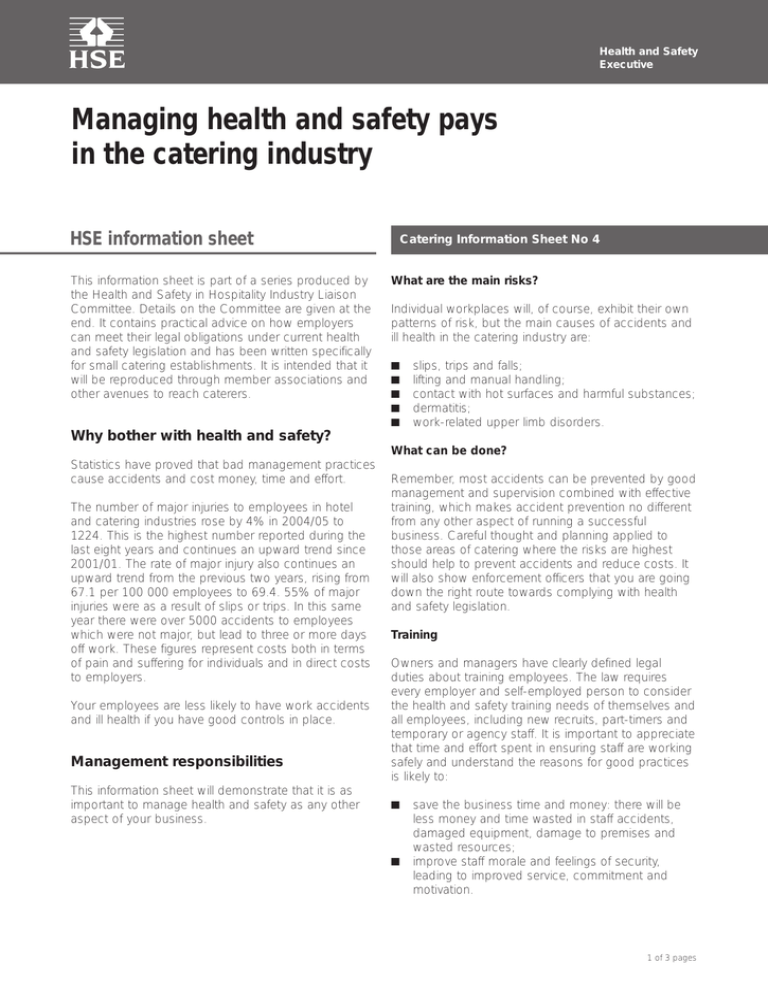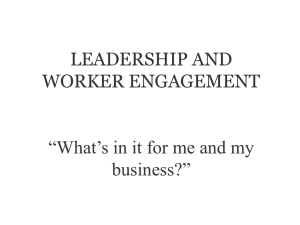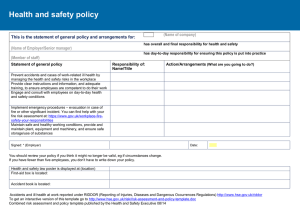Managing Health and Safety Managing Health and Safety 80kb
advertisement

Health and Safety Executive Managing health and safety pays in the catering industry HSE information sheet This information sheet is part of a series produced by the Health and Safety in Hospitality Industry Liaison Committee. Details on the Committee are given at the end. It contains practical advice on how employers can meet their legal obligations under current health and safety legislation and has been written specifically for small catering establishments. It is intended that it will be reproduced through member associations and other avenues to reach caterers. Catering Information Sheet No 4 What are the main risks? Individual workplaces will, of course, exhibit their own patterns of risk, but the main causes of accidents and ill health in the catering industry are: ■ ■ ■ ■ ■ slips, trips and falls; lifting and manual handling; contact with hot surfaces and harmful substances; dermatitis; work­related upper limb disorders. Why bother with health and safety? What can be done? Statistics have proved that bad management practices cause accidents and cost money, time and effort. The number of major injuries to employees in hotel and catering industries rose by 4% in 2004/05 to 1224. This is the highest number reported during the last eight years and continues an upward trend since 2001/01. The rate of major injury also continues an upward trend from the previous two years, rising from 67.1 per 100 000 employees to 69.4. 55% of major injuries were as a result of slips or trips. In this same year there were over 5000 accidents to employees which were not major, but lead to three or more days off work. These figures represent costs both in terms of pain and suffering for individuals and in direct costs to employers. Your employees are less likely to have work accidents and ill health if you have good controls in place. Management responsibilities This information sheet will demonstrate that it is as important to manage health and safety as any other aspect of your business. Remember, most accidents can be prevented by good management and supervision combined with effective training, which makes accident prevention no different from any other aspect of running a successful business. Careful thought and planning applied to those areas of catering where the risks are highest should help to prevent accidents and reduce costs. It will also show enforcement officers that you are going down the right route towards complying with health and safety legislation. Training Owners and managers have clearly defined legal duties about training employees. The law requires every employer and self­employed person to consider the health and safety training needs of themselves and all employees, including new recruits, part­timers and temporary or agency staff. It is important to appreciate that time and effort spent in ensuring staff are working safely and understand the reasons for good practices is likely to: ■ save the business time and money: there will be less money and time wasted in staff accidents, damaged equipment, damage to premises and wasted resources; ■ improve staff morale and feelings of security, leading to improved service, commitment and motivation. 1 of 3 pages Health and Safety Executive Consultation with employees The role of enforcement officers Good management of health and safety can only be achieved with the co­operation of the workforce. It is vital that your employees know what is expected of them and are aware of any risks to their health and safety that may arise at work and any safe systems of work that are applied. The co­operation of the workforce is likely to be more constructive if you consult with them about developing health and safety measures. Where you recognise a trade union, safety representatives must be consulted about the health and safety arrangements before action is taken. Where trade unions are not involved, the workforce should be encouraged to appoint its own safety representatives. This information sheet only refers to health and safety matters. It is not intended to cover food safety and hygiene requirements. Involving safety representatives helps ensure that health and safety measures will be effective in practice. So, enforcement officers are there to help businesses and promote health and safety. Summary Basic principles of the law Health and safety will not be a burden if managed properly. This information sheet does not attempt to explain the law in detail. It is simply a brief introduction to things that managers can do to prevent accidents and ill health at work. However, set out below is an outline of what the law requires in general. Managing health and safety effectively: ■ ensures it is not a burden; ■ keeps costs to a minimum and can bring savings; ■ prevents injury and ill health to your business’ most important resource: people; ■ reduces the likelihood of civil claims. Effective management of health and safety can best be achieved by: ■ realising it is an integral and essential part of business management; ■ identifying the main risk areas and taking action on those first; ■ setting yourself clear targets, for example to train staff and to clearly allocate responsibilities; ■ supervising adequately; ■ consulting staff at all stages. In most catering situations, local authority enforcement officers are responsible for the enforcement of health and safety legislation. Inspectors from HSE look after health and safety in catering facilities in institutions such as hospitals, schools etc. The role of the enforcement officer is not just to enforce the law but also to promote health and safety, give advice on the law and how to comply with it and advise on other sources of information – for example, a series of booklets available from HSE. The law requires you to ensure, as far as is reasonably practicable, the health and safety of yourself and others who may be affected by what you do or fail to do. The duties extend to people who: ■ work for you, including agency, casual, part­time ■ ■ ■ ■ ■ and trainee workers and subcontractors; use workplaces you provide; are allowed to use your equipment; visit your premises; may be affected by your work; use your professional services. You may provide catering services to other employers at their workplace. The law requires all employers sharing the same workplace to co­operate and co­ ordinate on health and safety. The law applies to all work premises and everyone at work – employee, supervisor, manager, director or self­employed – has duties. In practical terms you must identify the risks in your workplace and, as far as is reasonably practicable, take steps to reduce or eliminate them. In some cases, legislation related to the Health and Safety at Work etc Act may require specific measures to be taken. 2 of 3 pages Health and Safety Executive Health and Safety in Hospitality Industry Liaison Committee The Committee has been established by the hospitality industry and the Health and Safety Executive. It comprises trade and professional associations from the industry, trade unions and enforcement authorities. The Committee acts as a network to develop and communicate information and guidance through the industry and provides a forum where issues can be identified and resolved. Although its information sheets cannot be taken as definitive HSE guidance, they do give information on best practice from within the industry which has, in the past, been accepted by both HSE and local authority inspectors as a means of complying with health and safety legislation. Further advice and information HSE produces a wide range of documents. Some are available as printed publications, both priced and free, and others are only accessible via the HSE website, www.hse.gov.uk. HSE priced and free publications are available by mail order from HSE Books, PO Box 1999, Sudbury, Suffolk CO10 2WA Tel: 01787 881165 Fax: 01787 313995 Website: www.hsebooks.co.uk (HSE priced publications are also available from bookshops and free leaflets can be downloaded from HSE’s website: www.hse.gov.uk.) For information about health and safety ring HSE’s Infoline Tel: 0845 345 0055 Fax: 0845 408 9566 Textphone: 0845 408 9577 e­mail: hse.infoline@natbrit.com or write to HSE Information Services, Caerphilly Business Park, Caerphilly CF83 3GG. This document contains notes on good practice which are not compulsory but which you may find helpful in considering what you need to do. This document is available web only at www.hse.gov.uk/pubns/cais4.pdf © Crown copyright This publication may be freely reproduced, except for advertising, endorsement or commercial purposes. First published 09/95. Please acknowledge the source as HSE. Published by the Health and Safety Executive Redesigned 05/06 CAIS4 3 of 3 pages



